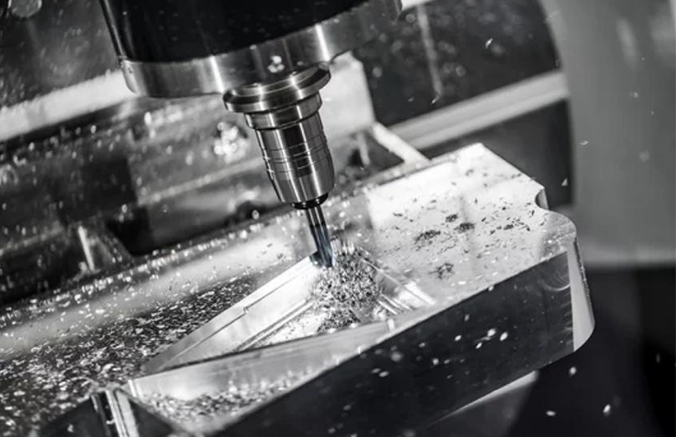In the ever-evolving landscape of modern manufacturing, CNC milling stands as a cornerstone of precision and efficiency. This blog aims to demystify the intricate workings of CNC milling, shedding light on its significance and offering a simplified explanation of its processes.

A CNC milling machine's understanding includes the workpiece, cutting tool, CNC controller, and motors with drive mechanisms. Notably, CNC differs markedly from manual milling, driven by meticulously coded instructions rather than manual operator control.
Before the milling process commences, meticulous design is essential. It involves using Computer-Aided Design (CAD) software to create precise part designs. CAD enables engineers to craft intricate designs down to the micrometer, ensuring that the final product meets exact specifications.
Once the design is complete, Computer-Aided Manufacturing (CAM) software comes into play. CAM generates toolpaths based on the CAD design, determining how the cutting tool will traverse the workpiece. This critical step translates the design into movements and operations that the CNC machine can execute flawlessly.
Selecting a suitable material is paramount in CNC milling. Engineers must choose materials that suit the application and are compatible with the CNC machine. The workpiece must be adequately prepared and firmly secured to prevent vibrations or displacement during milling.
Workholding devices play a pivotal role in securing the workpiece during milling. These devices, such as vises and clamps, must be chosen precisely. Tool selection and installation also demand meticulous attention, as the right tool ensures the desired accuracy of the final product.
The CNC program, typically written in G-code, serves as the instruction manual for the machine. It outlines every move the machine will make, from tool changes to cutting paths. Loading this program into the CNC controller is a crucial step.
Before milling can begin, the machine must be homed and zeroed. It involves aligning the machine's axes to a known reference point, ensuring the starting position is consistent for every job.
Safety is paramount in CNC milling. Protective gear and safety measures, including emergency stop buttons, are in place to safeguard operators and the machinery itself.
G-code is the language that CNC machines understand. It instructs the machine on tool movement and operation. The machine's coordinates, represented by the X, Y, and Z axes, guide the tool's path. Different types of toolpaths, including contouring, pocketing, and drilling, are utilized to achieve various machining operations.
With everything in place, the CNC milling process begins. The machine carefully moves the cutting tool across the workpiece, removing material and creating chips. Cooling and lubrication systems are vital in dissipating heat and preventing tool wear.
Real-time monitoring is integral to ensure precision and accuracy. Sensors and probes are deployed to assess the workpiece and make necessary adjustments. Quality control checks are conducted throughout the process, ensuring the final product meets exact specifications.
After machining is complete, the workpiece is removed from the machine. It undergoes inspection to verify that all dimensions meet requirements. Surface finishing processes, such as deburring and polishing, may be employed to achieve the desired surface quality. Detailed documentation of the job ensures future reference and replication.
CNC milling offers several advantages:
· Precision and Accuracy: CNC machines can achieve unparalleled precision, often down to micrometer levels.
· Increased Production Efficiency: Automation leads to faster production, reducing lead times.
· Complex Part Manufacturing: CNC can create intricate parts that would be challenging or impossible with manual methods.
· Repetitive and Consistent Results: CNC machines produce identical parts with remarkable consistency.
Numerous industries heavily rely on CNC milling, including:
· Aerospace: Precision components for aircraft and spacecraft.
· Automotive: Engine parts, chassis components, and more.
· Medical: Surgical instruments, prosthetics, and medical device components.
· Consumer Electronics: Smartphone casings and internal components.
· Telecommunication: Antenna arrays and communication equipment.
Fine-precision provides aerospace CNC milling and rapid prototyping CNC milling, feel free to contact us.
While CNC milling offers numerous benefits, challenges persist:
· Maintenance: Regular maintenance is crucial to keep CNC machines operating optimally.
· Initial Setup Costs: CNC machines require a significant upfront investment.
· Operator Training: Skilled operators are essential for efficient operation.
· Material Limitations: Some materials must be more suitable for CNC machining due to their properties.
The future of CNC milling is exciting and includes:
· Automation and Robotics Integration: Increased automation will further enhance efficiency.
· Advanced Materials and Tooling: Continued development of materials and cutting tools will expand capabilities.
· Sustainability: Embracing sustainable practices in CNC machining, such as reduced waste and energy efficiency, will become more prevalent.
CNC milling epitomizes precision manufacturing in the modern world. From design and programming to machining and quality control, this process ensures the creation of intricate components with unmatched accuracy. As industries continue to evolve, CNC milling will undoubtedly play a pivotal role in shaping the future of manufacturing. We encourage further exploration of this technology to unlock its full potential in your industry.